CHEVROLET CAVALIER 1995 3.G Owners Manual
Manufacturer: CHEVROLET, Model Year: 1995, Model line: CAVALIER, Model: CHEVROLET CAVALIER 1995 3.GPages: 340, PDF Size: 17.09 MB
Page 121 of 340
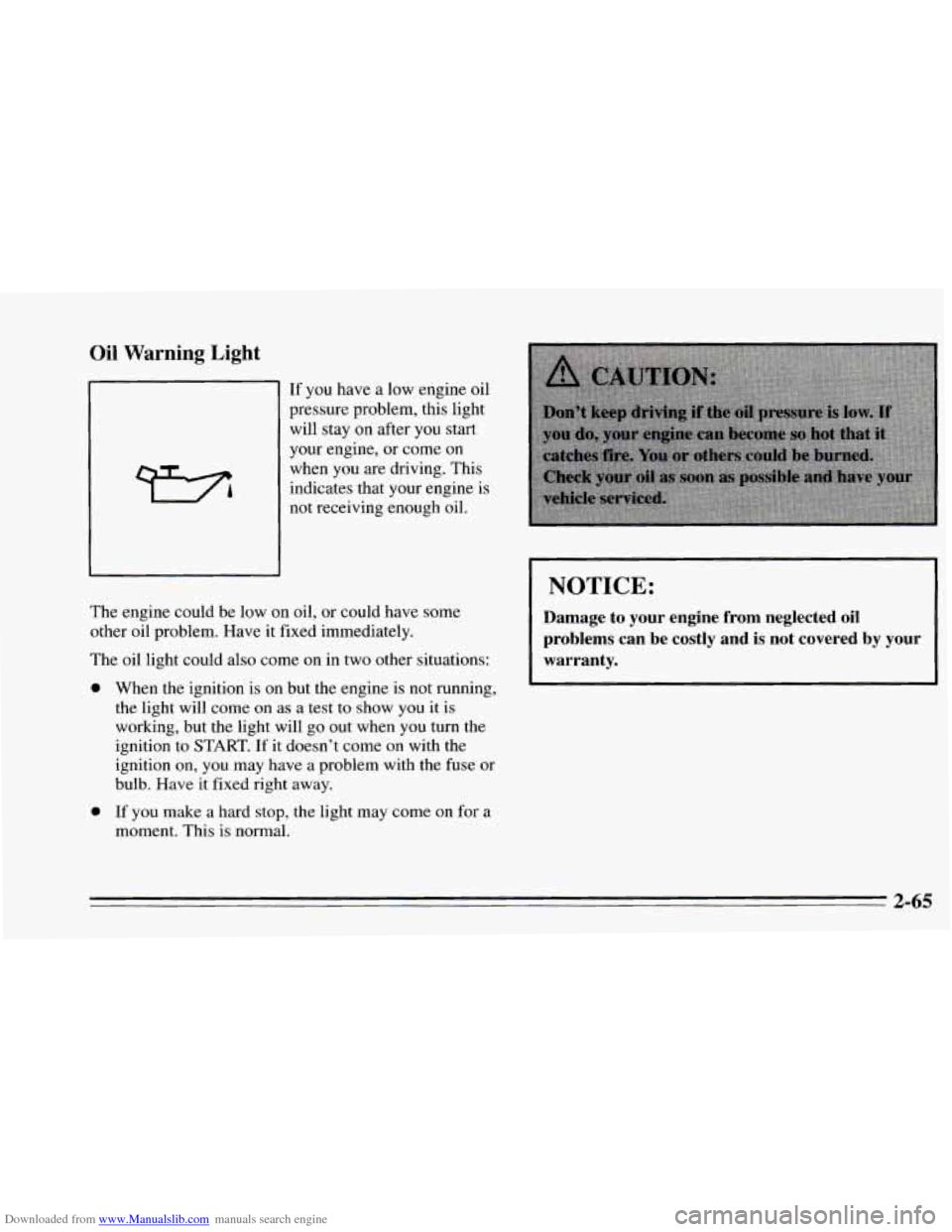
Downloaded from www.Manualslib.com manuals search engine Oil Warning Light
If you have a low engine oil
pressure problem, this light
will stay
on after you start
your engine, or come on
when you are driving. This
indicates that your engine is
not receiving enough oil.
The engine could be low on oil,
or could have some
other oil problem. Have it fixed immediately.
The oil light could also come on in two other situations:
0
0 When the ignition is on but the engine is not running,
the light will come on as a test to show
you it is
working, but the light will go out when you turn the
ignition to
START. If it doesn’t come on with the
ignition
on, you may have a problem with the fuse or
bulb. Have it fixed right away.
If you make a hard stop, the light may come on for a
moment. This is normal.
NOTICE:
Damage to your engine from neglected oil
problems can be costly and is not covered by your
warranty.
2-65
Page 122 of 340

Downloaded from www.Manualslib.com manuals search engine Check Oil Light
CHECK
OIL
This light should come on
briefly while you are
starting your engine.
If the
light doesn’t come
on, have
it repaired. If the light
comes
on while starting and
stays
on, your engine oil
level should be checked.
Charging System Light
The charging system light
will come
on briefly when
you turn on the ignition, and
the engine is not running, as
a check to show you
it is
working. Then it should
go
out.
Prior to checking your oil level, be sure your vehicle is
on
a level surface and has been shut off for several
minutes to allow the oil
to drain back into the oil pan.
Check your oil level and bring
it to the proper level.
See “Engine Oil” in
the Index.
The oil level monitoring system
only checks the oil
during the brief period between turning the key on and
when the engine starts.
It does not check the oil level
while the engine is running.
Parking
on steep grades may cause the light to come
on even when the oil level is correct. If this happens,
park the vehicle on a level surface and check the oil
level.
If it stays on, or comes on while you are driving, you
may have
a problem with the electrical charging system.
It could indicate that you have a loose generator drive
belt, or another electrical problem. Have
it checked right
away. Driving while this light
is on could drain your
battery.
If you must drive a short distance with the light on, be
certain
to turn off all your accessories, such as the radio
and air conditioner.
2-66
Page 123 of 340
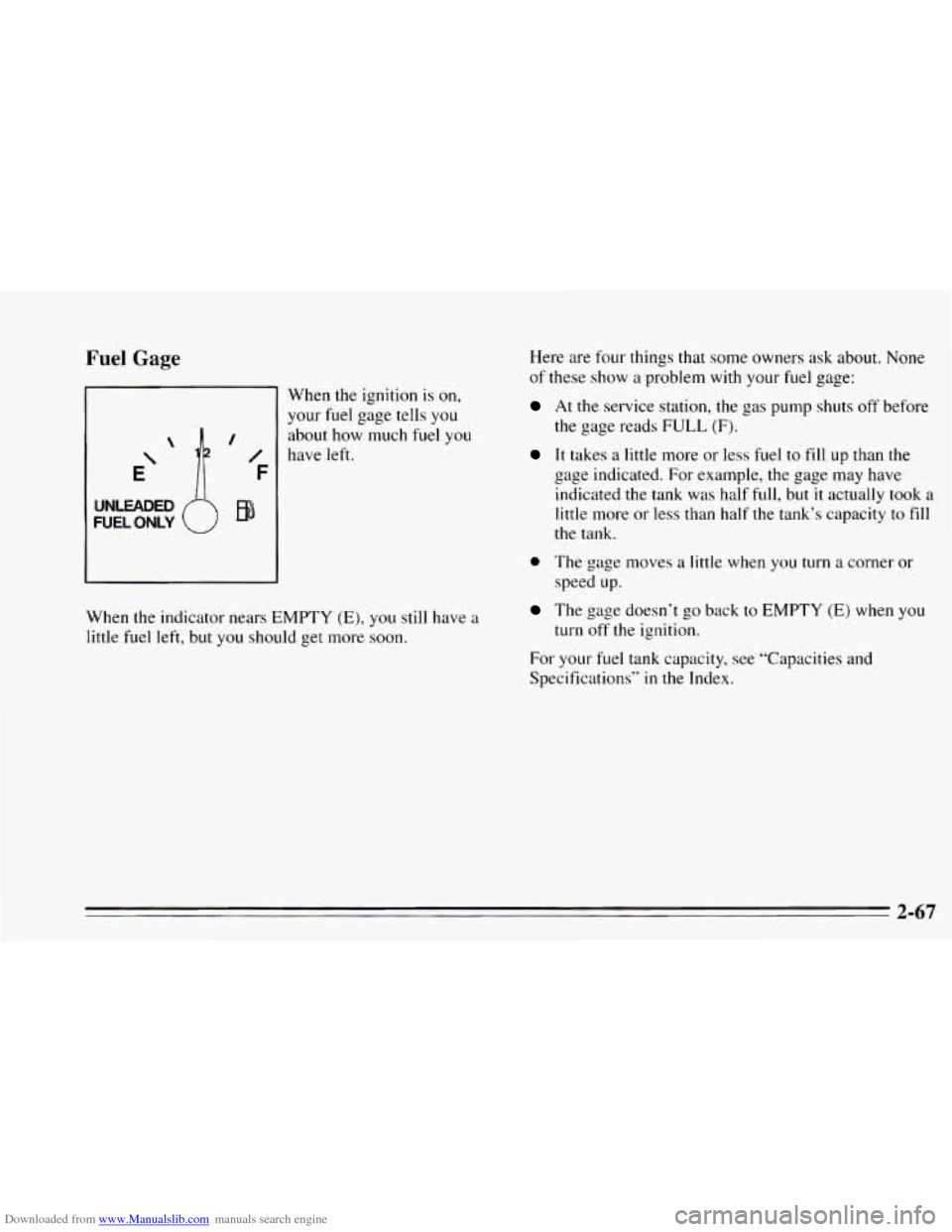
Downloaded from www.Manualslib.com manuals search engine Fuel Gage
/
/
F
UNLEADED
FUEL ONLY El9
When the ignition is on,
your fuel gage tells you
about how much
fuel you
have left.
When the indicator nears EMPTY
(E), you still have a
little fuel left, but you should get more soon.
Here are four things that some owners ask about. None
of these show a problem with your fuel gage:
At the service station, the gas pump shuts off before
the gage reads
FULL (F).
It takes a little more or less fuel to fill up than the
gage indicated. For example, the gage may have
indicated the tank was half
full, but it actually took a
little more or less than half the tank’s capacity to fill
the tank.
0 The gage moves a little when you turn a corner or
The gage doesn’t go back to EMPTY (E) when you
speed up.
turn off the ignition.
For your
fuel tank capacity, see “Capacities and
Specifications”
in the Index.
2-67
Page 124 of 340
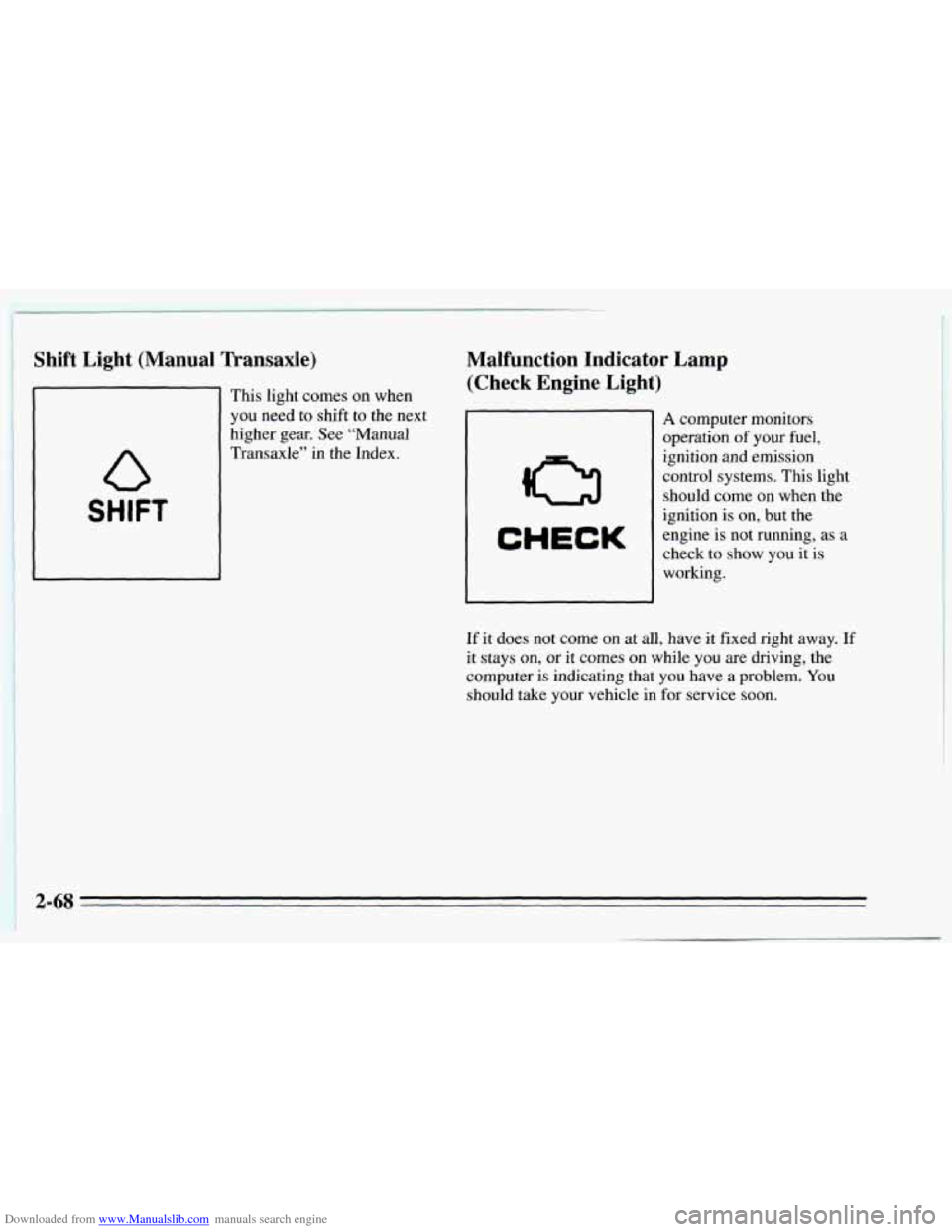
Downloaded from www.Manualslib.com manuals search engine i Shift Light (Manual Transaxle)
SHIFT
This light comes on when
you need to shift
to the next
higher gear. See “Manual
Transaxle” in the Index.
Malfunction Indicator Lamp
(Check Engine Light)
r A computer monitors
operation
of your fuel,
ignition and emission
control systems. This light
should come
on when the
ignition
is on, but the
engine is not running,
as a
check to show
you it is
working.
If it does not come on at all, have it fixed right away. If
it stays on, or it comes on while you are driving, the
computer is indicating that you have a problem. You
should take your vehicle in for service soon.
Page 125 of 340

Downloaded from www.Manualslib.com manuals search engine NOTICE:
If you keep driving your vehicle with this light
on, after a while the emission controls won’t
work as well, your fuel economy won’t
be as good
and your engine may not run as smoothly. This
could lead to costly repairs not covered by your
warranty.
If Your Vehicle
Is Equipped with OBD I1
(2.3L Code D Engine Only)
Certain vehicles are equipped with a new emission
diagnostic system. You can tell whether your vehicle has
this system by reading your tune-up label located under
the hood. If the label says
“OBD 11” on it. the following
instructions apply.
Your Chevrolet
is equipped with an onboard computer
which monitors operation
of the emission control
system. This system
is called OBD I1 (On-Board
Diagnostics
-- Second Generation) and is intended to
assure that emissions are at acceptable levels for the life
of the vehicle, helping to produce a cleaner
environment. The
CHECK ENGINE light comes on to
indicate when service is require.d. Malfunctions often
will be indicated by the system before any problem is apparent,
which may prevent more serious damage
tc,
your vehicle. This system is also designed to assist your
service technician
in correctly diagnosing any
malfunction.
The
CHECK ENGINE light should come on, as a check
to show
you it is working, when the ignition is on and
the engine is
not running. This light will also come on
during a malfunction in one of two ways:
Light On Steady: This indicates a system
malfunction has been detected. Drive the vehicle
to
the dealer for service at your first opportunity.
Light Flashing: This indicates a misfire has been
detected which may damage the emission control
system. The damage may be reduced by Iowering the
vehicle speed, reducing the amount
of cargo being
hauled or trailered, avoiding hard acceleration,
or by
avoiding steep uphill grades.
If these actions are
effective,
the light will stop flashing and remain on
steady. Drive the vehicle to a dealer for service. If
the light continues to flash, stop the vehicle. Wait for
a steady light to come on, then drive the vehicle to
a
dealer for service.
2-69
Page 126 of 340
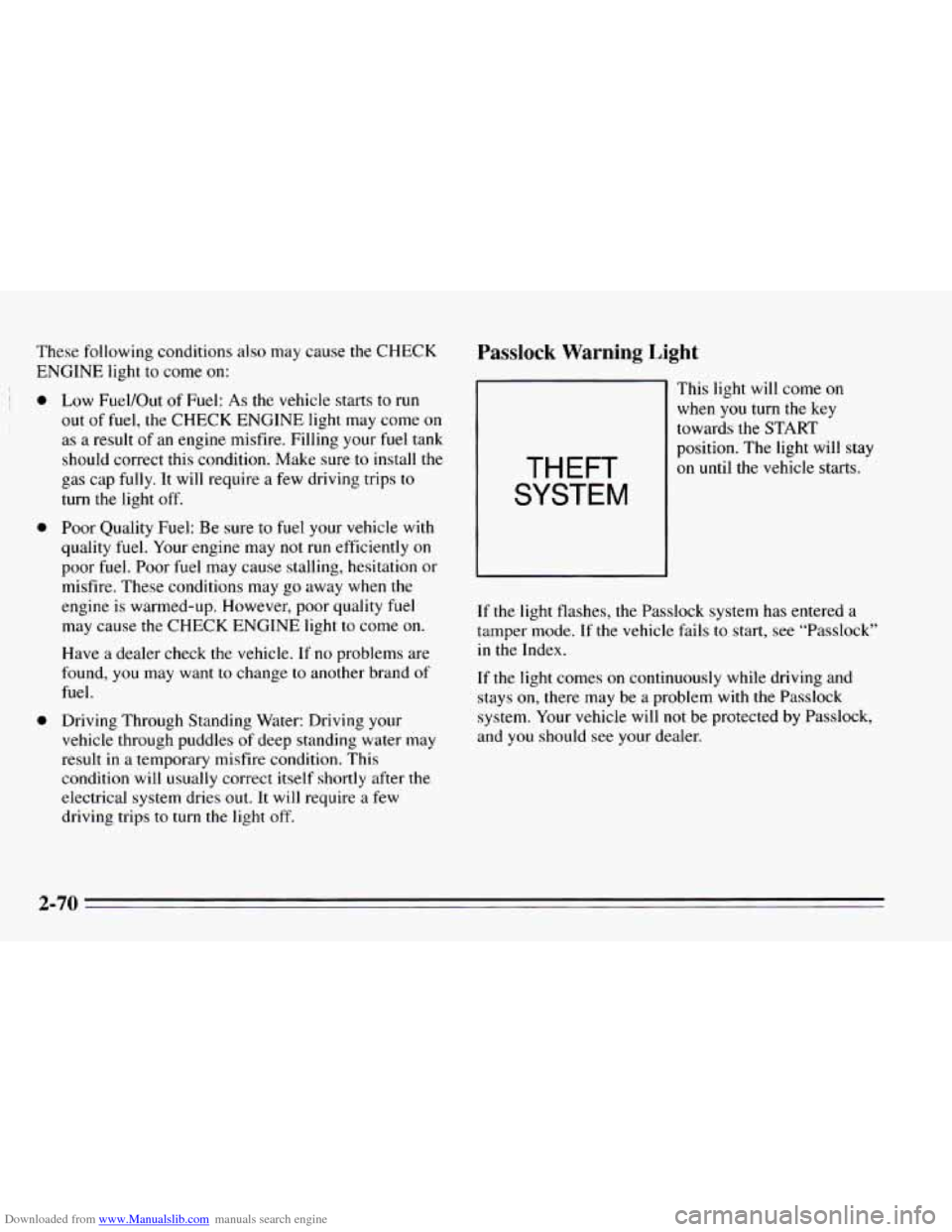
Downloaded from www.Manualslib.com manuals search engine These following conditions also may cause the CHECK
ENGINE light to come
on:
0
0
Low Fuel/Out of Fuel: As the vehicle starts to run
out of fuel, the CHECK ENGINE light may come on
as a result of an engine misfire. Filling your fuel tank
should correct this condition. Make sure to install
the
gas cap fully. It will require a few driving trips to
turn the light off.
Poor Quality Fuel: Be sure to fuel your vehicle with
quality fuel. Your engine may
not run efficiently on
poor fuel. Poor fuel may cause stalling, hesitation or
misfire. These conditions may
go away when the
engine
is warmed-up. However, poor quality fuel
may cause the
CHECK ENGINE light to come on.
Have a dealer check the vehicle. If no problems are
found, you may want
to change to another brand of
fuel.
Driving Through Standing Water: Driving your
vehicle through puddles
of deep standing water may
result in
a temporary misfire condition. This
condition will usually correct itself shortly after
the
electrical system dries out. it will require a few
driving trips
to turn the light off.
Passlock Warning Light
THEFT
SYSTEM
This light will come on
when you turn the key
towards the
START
position. The light will stay
on until the vehicle starts.
If the light flashes, the Passlock system has entered a
tamper mode.
If the vehicle fails to start, see “Passlock”
in the Index.
If
the light comes on continuously while driving and
stays
on, there may be a problem with the Passlock
system. Your vehicle will not be protected
by Passlock,
and
you should see your dealer.
2-70
Page 127 of 340
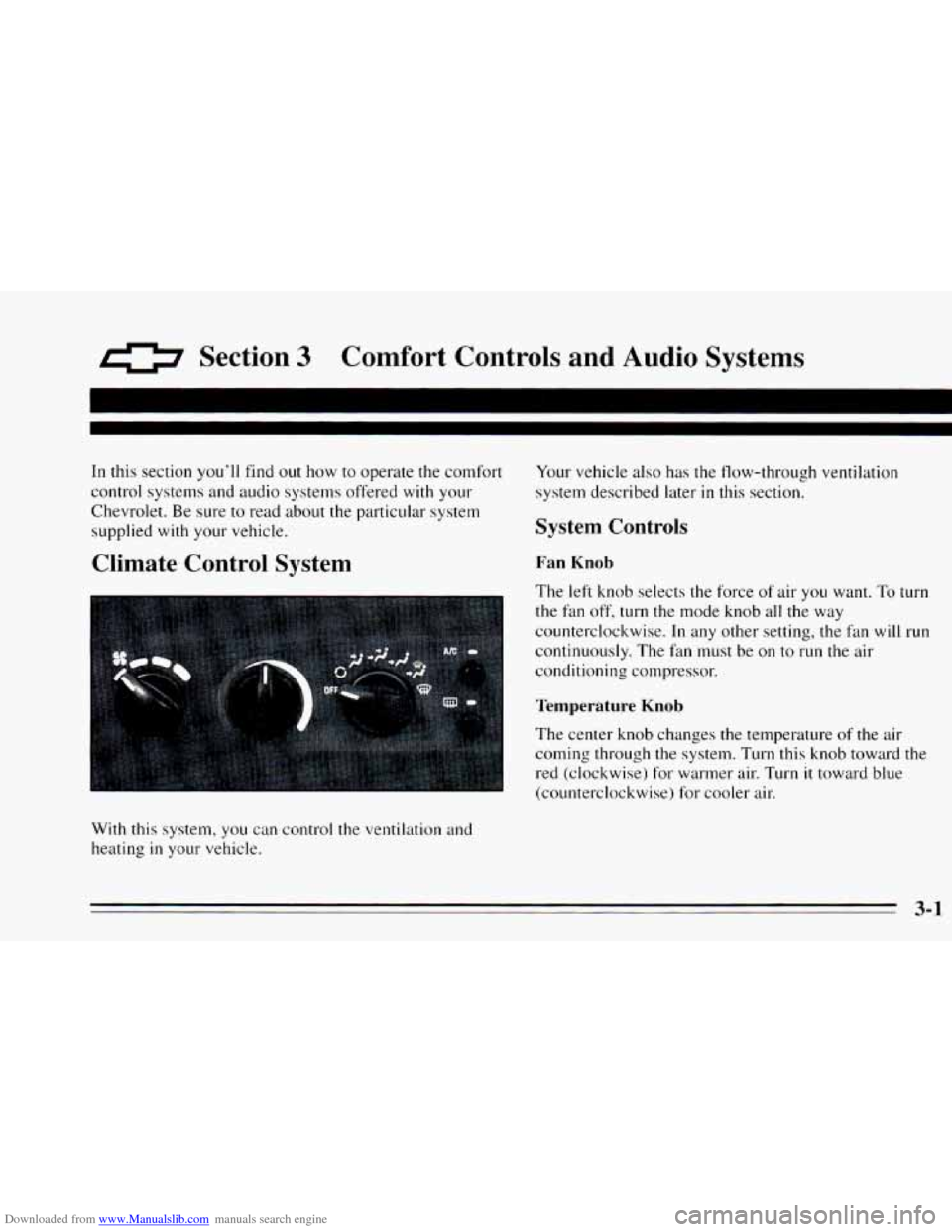
Downloaded from www.Manualslib.com manuals search engine 0 Section 3 Comfort Controls and Audio Svstems J
In this section you’ll find out how to operate the comfort
control systems and audio systems offered with your
Chevrolet. Be sure
to read about the particular system
supplied with your vehicle.
Climate Control System
With this system, you can control the ventilation and
heating
in your vehicle. Your
vehicle also has the flow-through ventilation
system described later
in this section.
System Controls
Fan Knob
The left knob selects the force of air you want. To turn
the fan off, turn the mode knob all the way
counterclockwise.
In any other setting, the fan will run
continuously. The fan must
be on to run the air
conditioning compressor.
Temperature Knob
The center knob changes the temperature of the air
coming through
the system. Turn this knob toward the
red (clockwise) for warmer air. Turn it toward blue
(counterclockwise) for cooler air.
3-1
Page 128 of 340
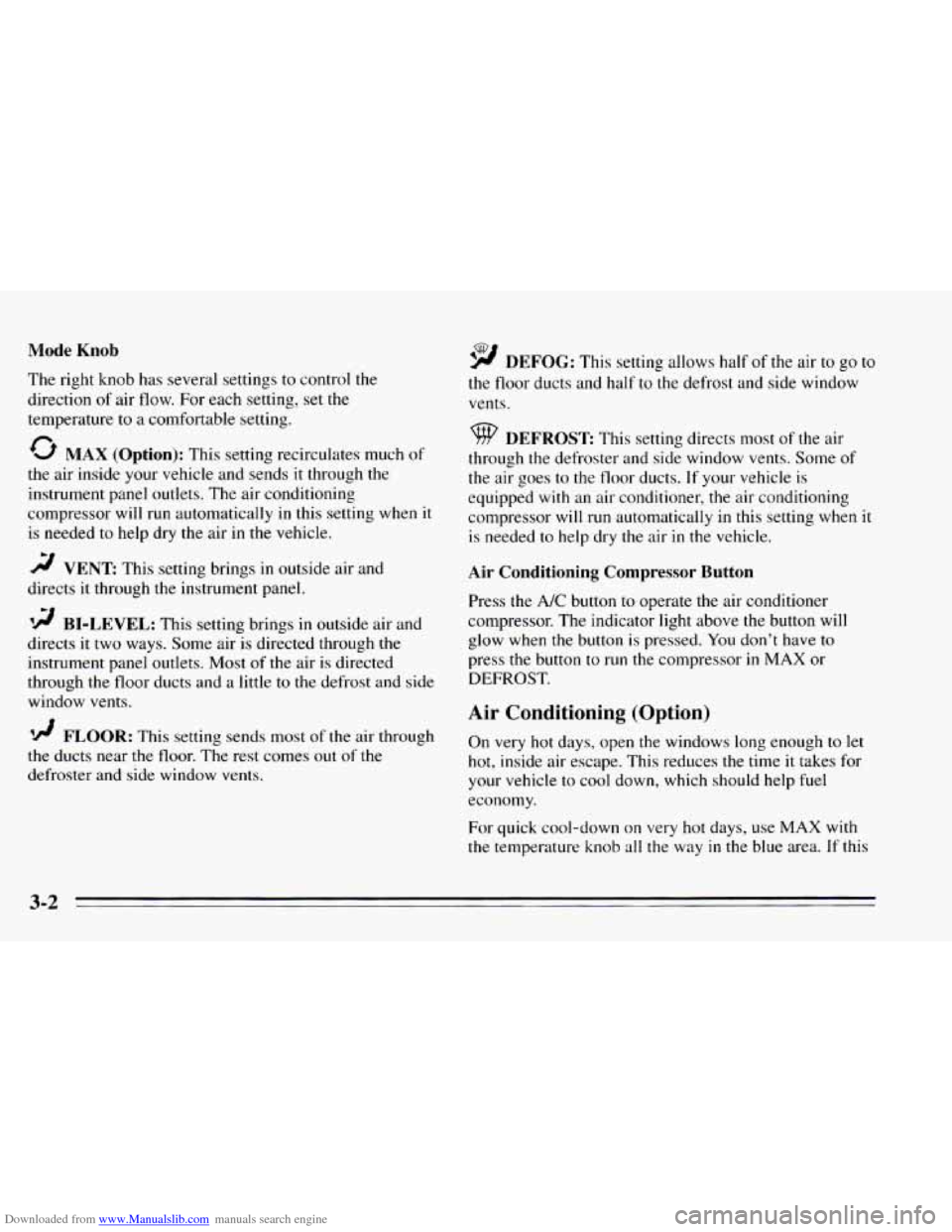
Downloaded from www.Manualslib.com manuals search engine Mode Knob
The right knob has several settings to control the
direction
of air flow. For each setting, set the
temperature to a comfortable setting.
0 MAX (Option): This setting recirculates much of
the air inside your vehicle and sends it through the
instrument panel outlets. The air conditioning
compressor will run automatically
in this setting when it
is needed to help dry the air in the vehicle.
2 VENT: This setting brings in outside air and
directs it through the instrument panel.
BI-LEVEL: This setting brings in outside air and
directs
it two ways. Some air is directed through the
instrument panel outlets. Most of the air is directed
through the floor ducts and a little
to the defrost and side
window vents.
1j FLOOR: This setting sends most of the air through
the ducts near the floor. The rest comes
out of the
defroster and side window vents.
9 DEFOG: This setting allows half of the air to go to
the floor ducts and half to the defrost and side window
vents.
9 DEFROST: This setting directs most of the air
through the defroster and side window vents. Some
of
the air goes to the floor ducts. If your vehicle is
equipped with an
air conditioner, the air conditioning
compressor will
run automatically in this setting when it
is needed to help dry
the air in the vehicle.
Air Conditioning Compressor Button
Press the A/C button to operate the air conditioner
compressor. The indicator light above the button will
glow when the button
is pressed. You don’t have to
press
the button to run the compressor in MAX or
DEFROST.
Air Conditioning (Option)
On very hot days, open the windows long enough to let
hot, inside air escape. This reduces the time it takes for
your vehicle to cool down, which should help fuel
economy.
For quick cool-down on very hot days, use
MAX with
the temperature
knob all the way in the blue area. If this
3-2
Page 129 of 340
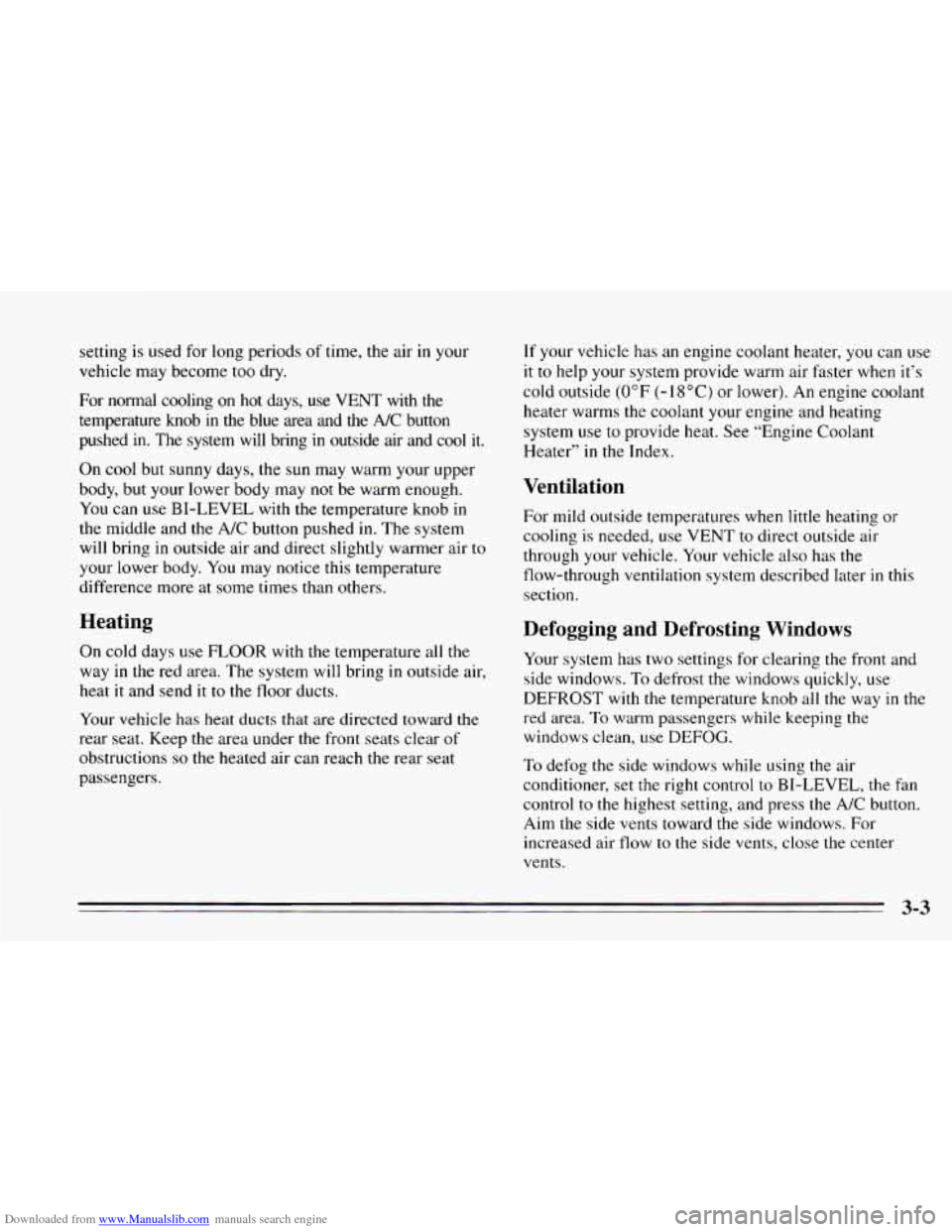
Downloaded from www.Manualslib.com manuals search engine setting is used for long periods of time, the air in your
vehicle may become too dry.
For normal cooling
on hot days, use VENT with the
temperature knob in the blue area and the
NC button
pushed in. The system will bring in outside air and cool it.
On cool but sunny days, the sun may warm your upper
body, but your lower body may not be warm enough.
You can use BI-LEVEL with the temperature knob in
the middle and the A/C button pushed
in. The system
will bring in outside air and direct slightly warmer air to
your lower body. You may notice this temperature
difference more at some times
than others.
Heating
On cold days use FLOOR with the temperature all the
way in the red area. The system will bring in outside air,
heat it and send
it to the floor ducts.
Your vehicle has heat ducts that are directed toward the
rear seat. Keep the area under the front seats clear
of
obstructions so the heated air can reach the rear seat
passengers.
If your vehicle has an engine coolant heater, you can use
it to help your system provide warm air faster when it’s
cold outside (0°F (-18°C) or lower). An engine coolant
heater warms
the coolant your engine and heating
system use
to provide heat. See “Engine Coolant
Heater” in the Index.
Ventilation
For mild outside temperatures when little heating or
cooling is needed, use VENT to direct outside air
through your vehicle. Your vehicle also has the
flow-through ventilation system described later
in this
section.
Defogging and Defrosting Windows
Your system has two settings for clearing the front and
side windows. To defrost
the windows quickly, use
DEFROST with the temperature knob all
the way in the
red area. To warm passengers while keeping the
windows clean, use
DEFOG.
To defog the side windows while using the air
conditioner, set the right control to BI-LEVEL, the fan
control
to the highest setting, and press the A/C button.
Aim
the side vents toward the side windows. For
increased air flow
to the side vents, close the center
vents.
3-3
Page 130 of 340
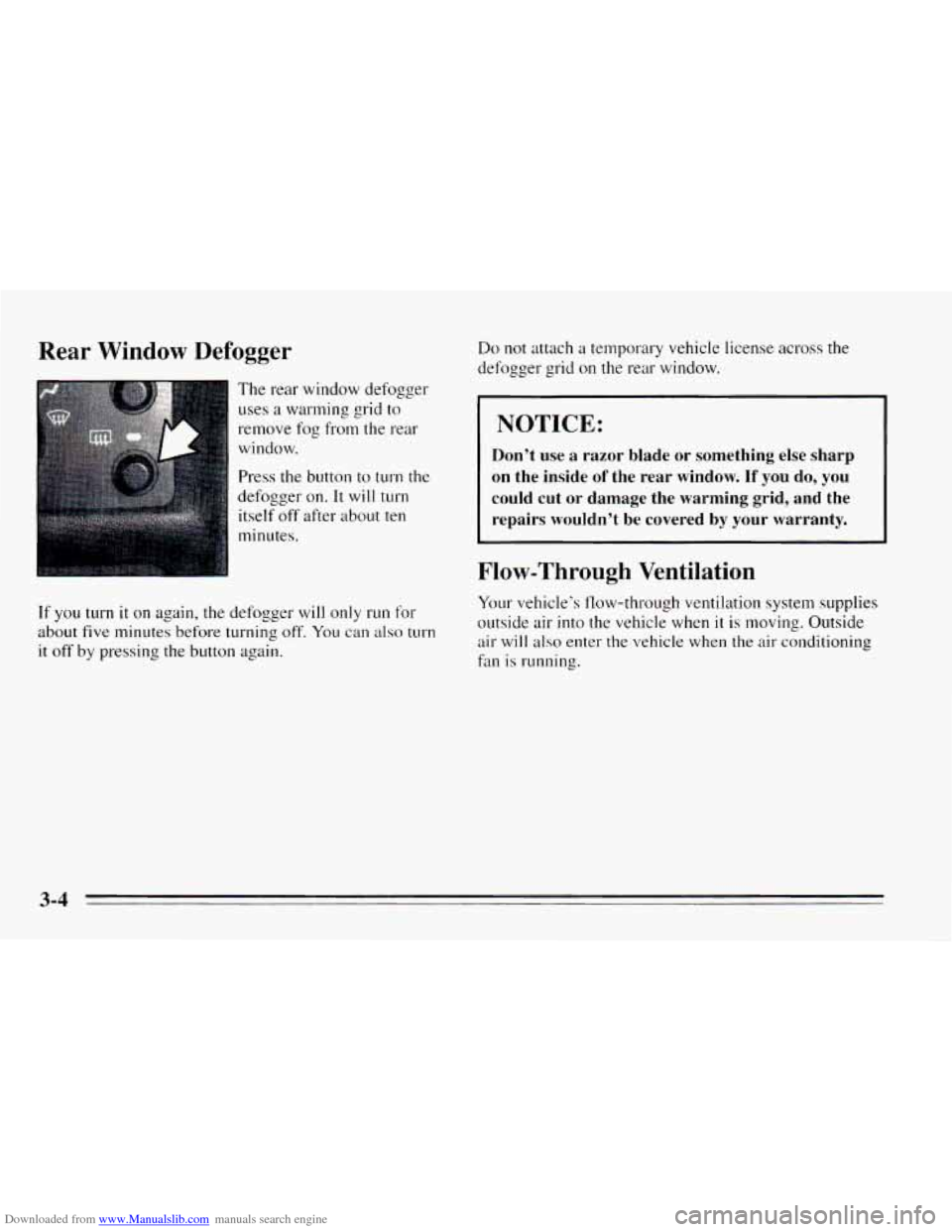
Downloaded from www.Manualslib.com manuals search engine Rear Window Defogger
The rear window defogger
uses a warming grid to
remove fog from the rear
window.
Press
the button to t11rn the
defogger on.
It will turn
itself
off after about ten
minutes.
If you turn it on again, the defogger will only run for
about five minutes before turning off. You can also turn
it off by pressing the button again.
Do not attach a temporary vehicle license across the
defogger grid on
the rear window.
I NOTICE:
Don’t use a razor blade or something else sharp
on the inside
of the rear window. If you do, you
could cut or damage the warming grid, and the
repairs wouldn’t be covered by your warranty.
Flow-Through Ventilation
Your vehicle’s flow-through ventilation system supplies
outside air into the vehicle when
it is moving. Outside
air will
also enter the vehicle when the air conditioning
fan is running.
3-4